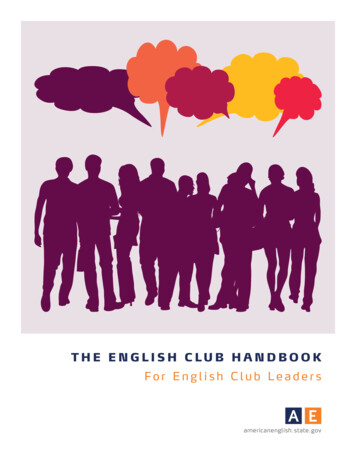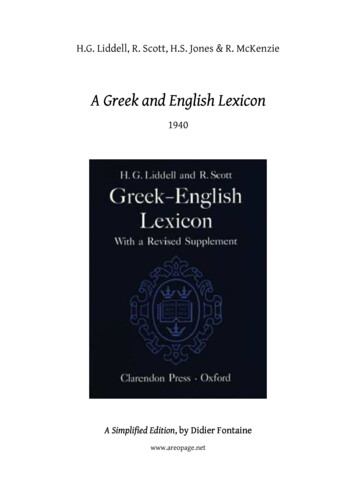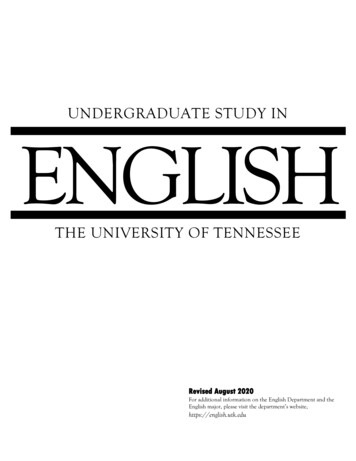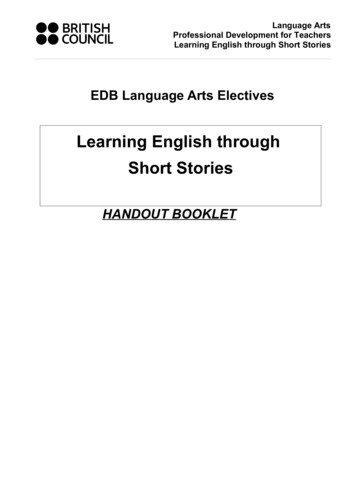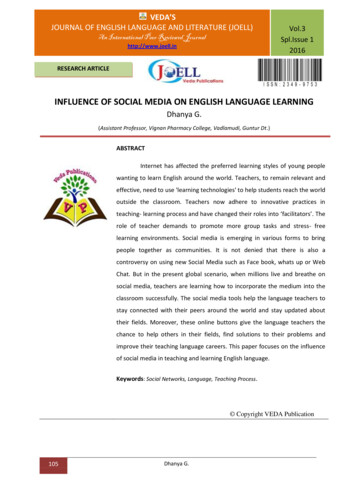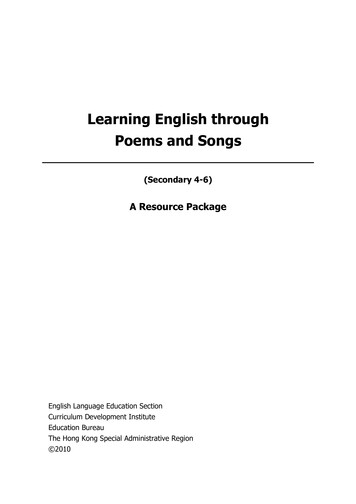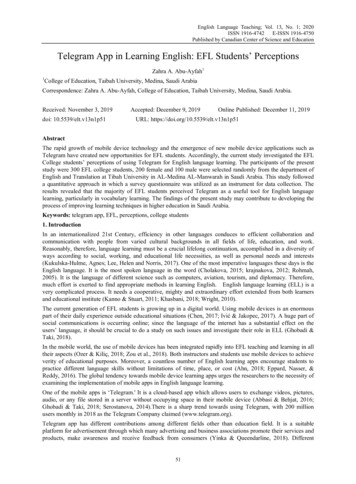
Transcription
English Language Teaching; Vol. 13, No. 1; 2020ISSN 1916-4742E-ISSN 1916-4750Published by Canadian Center of Science and EducationTelegram App in Learning English: EFL Students’ PerceptionsZahra A. Abu-Ayfah11College of Education, Taibah University, Medina, Saudi ArabiaCorrespondence: Zahra A. Abu-Ayfah, College of Education, Taibah University, Medina, Saudi Arabia.Received: November 3, 2019doi: 10.5539/elt.v13n1p51Accepted: December 9, 2019Online Published: December 11, 2019URL: https://doi.org/10.5539/elt.v13n1p51AbstractThe rapid growth of mobile device technology and the emergence of new mobile device applications such asTelegram have created new opportunities for EFL students. Accordingly, the current study investigated the EFLCollege students’ perceptions of using Telegram for English language learning. The participants of the presentstudy were 300 EFL college students, 200 female and 100 male were selected randomly from the department ofEnglish and Translation at Tibah University in AL-Medina AL-Manwarah in Saudi Arabia. This study followeda quantitative approach in which a survey questionnaire was utilized as an instrument for data collection. Theresults revealed that the majority of EFL students perceived Telegram as a useful tool for English languagelearning, particularly in vocabulary learning. The findings of the present study may contribute to developing theprocess of improving learning techniques in higher education in Saudi Arabia.Keywords: telegram app, EFL, perceptions, college students1. IntroductionIn an internationalized 21st Century, efficiency in other languages conduces to efficient collaboration andcommunication with people from varied cultural backgrounds in all fields of life, education, and work.Reasonably, therefore, language learning must be a crucial lifelong continuation, accomplished in a diversity ofways according to social, working, and educational life necessities, as well as personal needs and interests(Kukulska-Hulme, Agnes; Lee, Helen and Norris, 2017). One of the most imperative languages these days is theEnglish language. It is the most spoken language in the word (Cholakova, 2015; krajnakova, 2012; Rohmah,2005). It is the language of different science such as computers, aviation, tourism, and diplomacy. Therefore,much effort is exerted to find appropriate methods in learning English. English language learning (ELL) is avery complicated process. It needs a cooperative, mighty and extraordinary effort extended from both learnersand educational institute (Kanno & Stuart, 2011; Khasbani, 2018; Wright, 2010).The current generation of EFL students is growing up in a digital world. Using mobile devices is an enormouspart of their daily experience outside educational situations (Chen, 2017; Ivić & Jakopec, 2017). A huge part ofsocial communications is occurring online; since the language of the internet has a substantial effect on theusers’ language, it should be crucial to do a study on such issues and investigate their role in ELL (Ghobadi &Taki, 2018).In the mobile world, the use of mobile devices has been integrated rapidly into EFL teaching and learning in alltheir aspects (Ozer & Kiliç, 2018; Zou et al., 2018). Both instructors and students use mobile devices to achieveverity of educational purposes. Moreover, a countless number of English learning apps encourage students topractice different language skills without limitations of time, place, or cost (Ahn, 2018; Eppard, Nasser, &Reddy, 2016). The global tendency towards mobile device learning apps urges the researchers to the necessity ofexamining the implementation of mobile apps in English language learning.One of the mobile apps is ‘Telegram.' It is a cloud-based app which allows users to exchange videos, pictures,audio, or any file stored in a server without occupying space in their mobile device (Abbasi & Behjat, 2016;Ghobadi & Taki, 2018; Serostanova, 2014).There is a sharp trend towards using Telegram, with 200 millionusers monthly in 2018 as the Telegram Company claimed (www.telegram.org).Telegram app has different contributions among different fields other than education field. It is a suitableplatform for advertisement through which many advertising and business associations promote their services andproducts, make awareness and receive feedback from consumers (Yinka & Queendarline, 2018). Different51
elt.ccsenet.orgEnglish Language TeachingVol. 13, No. 1; 2020studies express the argument of whether the telegram app develops or reduces teaching and learning Englishlanguage process.Many previous studies proved the effectiveness of the Telegram app in teaching and learning the Englishlanguage (Heidari-shahreza & Khodarahmi, 2018; Xodabande, 2017). The adoption of Telegram in Englishlanguage learning ameliorate different angles of EFL learners’ English language skills, such as readingcomprehension ability (Naderi & Akrami, 2018), vocabulary (Ghobadi & Taki, 2018), writing skill (Aghajani &Adloo, 2018), and improving speaking skill (Setiawan & Wahyuni, 2017; Xodabande, 2017). However, it iscrucial to know how EFL students find Telegram as a tool that assists them in English language learning.It is essential to cognize that students' perception of telegram plays a critical role in defining the success of theTelegram app. If English students perceive that Telegram is easy to apply and useful, they tend to show a high ofboth satisfaction and motivation, and positive attitude, which will lead them to deduce this app (Ahn, 2018).Furthermore, Gangaiamaran and Pasupathi (2017) recommended for future study that there is a need to shedlight on students' perceptions towards mobile apps as an ELL tool; nevertheless, Dashtestani (2013) pointed tothe necessity of conducting more research to evaluate the efficiency of the implementation of MALL from theoverview of language learners.Regarding the researcher’s experience and research’s limitation, the Saudi context does not have any publishedstudies that discussed the perception of EFL college students of using the Telegram for English languagelearning.Thus, the study investigated the EFL college students’ perception of using Telegram for English languagelearning.The findings of the current study may contribute to developing the process of improving learning techniques inhigher education in Saudi Arabia. It may draw college students' attention to the importance of EFL mobileapplications and their role in providing different EFL activities, as well as it may raise students' awarenesstoward implementing mobile apps in EFL learning process, and in improving EFL learning process. Also, itmight encourage self-study and change in the learners' roles.It may give an indication to the decision makers and Saudi educationalists positively or negatively about thebenefit of the EFL mobile apps to students, which helps them to improve the educational process for EFL. Inother words, it may afford insight to administrators of university and scholars to enhance the process of teachingand learning a foreign language in Saudi Arabia. Moreover, it may encourage apps providers to modify, improveor create a verity of EFL educational applications.2. Literature ReviewMany previous studies proved the effectiveness of the Telegram app in teaching and learning the Englishlanguage (Heidari-shahreza & Khodarahmi, 2018; Xodabande, 2017). The adoption of Telegram in Englishlanguage learning ameliorate different angles of EFL learners’ English language skills, such as readingcomprehension ability (Naderi & Akrami, 2018), vocabulary (Ghobadi & Taki, 2018), writing skill (Aghajani& Adloo, 2018), and improving speaking skill (Setiawan & Wahyuni, 2017; Xodabande, 2017).Akobirov and Vokhidova (2018) discussed the significance of mobile learning in teaching and learning theEnglish language. They focused on mobile application "Telegram." Their study showed that using Telegram inteaching language skills could be very promising and useful.Telegram app has an impact on English language skills such as reading, writing, listening, and speaking. Naderiand Akrami (2018) stated that using telegram groups in instruction has a significant effect on the learners'reading comprehension ability. They affirmed that it improved the learners’ ability in reading comprehension.In the same context of implementing Telegram app in the educational process of English skills, there were two ofa previous study (Abbasi & Behjat, 2016; Setiawan & Wahyuni, 2017; Xodabande, 2017) which concentrated onimproving speaking ability. Abbasi and Behjat (2016) investigated the effect of storytelling with Telegram onEFL students ’speaking complexity. The result showed that the experimental group outperformed the controlgroup regarding their speaking complexity.Additionally, Setiawan and Wahyuni (2017) showed the role of E-talk Castel's model in improving students'speaking skill in English by using a recording tool in telegram application. The results revealed thatimplementing E- talk castle model supported by Telegram provided students with good aid to improve theirEnglish speaking skill.52
elt.ccsenet.orgEnglish Language TeachingVol. 13, No. 1; 2020Setiawan and Wahyuni's (2017) study is affirmed by Xodabande (2017) who examined the usability of Telegramin teaching pronunciation of the English language to EFL learners. The findings showed that the use of Telegramcontributed significantly to amelioration in participants’ pronunciation. The researcher indicated that teachingthe English language using Telegram can be promising and very useful.Another English skill that was taught with implementing the Telegram app was writing ability. Aghajani andAdloo (2018) stated that participants in Telegram Cooperative writing groups displayed slightly higher scorescompared to face-to-face cooperative writing groups. They claimed that popular mobile devices bring a vastpotential to Telegram learning regarding pervasiveness, ubiquity, personalization, and flexibility.The Telegram also has contributions in vocabulary acquisition of the English language. One of the telegramfeatures is stickers which have a crucial role in vocabulary acquisition. Ghobadi and Taki (2018) indicated thatteaching vocabulary via Telegram stickers could assist in outstanding advantages for the learners. Theresearchers stated that Telegram had a positive impact on learning new vocabulary items among EFL learners.The results of Ghobadi and Taki (2018) came in line with the findings of a case study done by Heidari-shahrezaand Khodarahmi (2018). The authors explored the Telegram role in mastering word stress patterns of Englishlanguage by EFL learners. The findings showed a statistically significant difference in the fever of theexperimental group.Moreover, the students had a positive attitude about learning new words via Telegram. Ghaemi and Golshan(2018) examined the effects of short messages services (SMS) via Telegram on EFL students' vocabularylearning process. The researchers assert that the use of SMS via Telegram as a teaching tool affected students'vocabulary learning positively.On the other hand, Bello and Hadiza (2017) indicated the usability of using Telegram as a teaching tool. Theyassigned that Telegram could provide English teachers with appropriate materials to produce valuable andfabulous instructions. The researchers recommended English teacher to prepare well to be able to use Telegramin the classroom efficiently.Nevertheless, Zarei (2015) examined the effectiveness of using Telegram app as teaching tools for languagelearning. The study used mixed to investigate the effect of using Telegram app on providing feedback anddeveloping writing accuracy in L2 and to investigate students' perceptions of using Telegram app for writingpurpose. The findings showed that the experimental group using Telegram have better performance than thecontrol group. Student perceptions showed usefulness and satisfaction of using Telegram app for writingpurpose.Ibrahim, Norsaal, Abdullah, Soh, and Othman (2016) and Yinka and Queendarline (2018) concentrated onstudents’ perception toward implementing Telegram in English teaching and writing. Yinka and Queendarline(2018) found out that students use telegram for both learning and teaching purposes. They recommended thatthe telegram using have to be combined into the curriculum of the higher institution to develop the education ofUniversities.Furthermore, Ibrahim et al. (2016) indicated that the Telegram app supports learning and teaching enhancementby offering a quick and easy way of creating and sharing information.Many of previous studies were conducted on the effectiveness of the Telegram app in teaching and learningEnglish language skills (Aghajani & Adloo, 2018; Heidari-shahreza & Khodarahmi, 2018; Xodabande, 2017).However, there are little previous studies that examine the learners' perception of using Telegram as a mobiledevice' application in EFL education (Zamakhsari, 2018).Besides, in the Saudi context, smartphone proved its outperformance in EFL learning. Ahmed (2015) examinedsmartphones enhancement of EFL learning mainly on linguistic knowledge and language skills. The researchsheds light on learners' vocabulary acquisition, listening, speaking, reading and writing. The researcher affirmedthat EFL students who used smartphones were more enthusiastic than those who were still held in paper-textmaterials. This affirmation was reinforced by Al Fadda & Al Qasim (2013) who shed light on improvinglistening comprehension via podcasting. The authors exposed that applied of podcasts can create a positive andsignificant difference to the EFL listening comprehension for EFL Saudi students.Nevertheless, Hazaea & Alzubi (2016) showed that applying WhatsApp, mobile camera, online and offlinedictionaries, memos and online resources improved the students’ text participation practices and code-breakingpractices while text-analyzing practices and text using were faintly improved. Taking into account the studiesconducted in the Saudi context; the MALL proved its effectiveness among EFL students in Saudi Arabia.53
elt.ccsenet.orgEnglish Language TeachingVol. 13, No. 1; 2020However, according to search and limitation of the researcher, no any published study in the Saudi contextdiscusses the perception of EFL Learners towards using the Telegram as a mobile device' application to enhancelearning the English language.Despite that any decision relating to integrating new technology into the educational process is often made by thedecision maker, the success of this integration is based on the students’ intentions to accept and adopt this newtechnology. Thus, knowing how individuals perceive new technology has been of interest to many researchers.Furthermore, it is crucial to understand the reasons why some students accept and adopt a particular technologyand reject another (Al-Lozi, Al-Hujran, & Al-Debei, 2016).Therefore, the current study aimed to investigate EFL college students' perception of using Telegram in Englishlanguage learning. The results reflection of the current study may provide an understanding of mobile learning,particularly ELL via Telegram. It would assist decision makers in developing successful strategies forM-Learning adoption. Shortly, this research sought to answer the following question: What are the EFL collegestudents’ perceptions of using Telegram app for English language learning?3. Method3.1 Research ApproachThis descriptive study makes use of a quantitative research strategy in the sense that there will be quantitativedata was produced.3.2 Population and SampleThe number of population was (1609) including (1161) female and (448) male. The percentage of the samplewas (23%). They were 300 EFL college students, 200 female and 100 male selected randomly, based on simplerandom sampling, from the department of English and Translation at Tibah University in AL-MedinaAL-Manwarah in Saudi Arabia.3.3 The Participants’ DemographicsThree hundred of EFL college students participated in the study. Descriptive statistics for the participants’demographic information are listed in the Figure1.Figure 1. Description of the sample genderMales comprised 100 (33 %) of the participants, while females predominated, with 200 (67%).54
elt.ccsenet.orgEnglish Language TeachingVol. 13, No. 1; 2020Figure 2. Do you use TelegramRegarding the user of Telegram App, there are about (83%) of students use Telegram, while about 17% ofstudents don’t use it as illustrated in the Figure 2.Figure 3. Do you intend to use TelegramAmong the Telegram nonusers, 38 (70%) intended to use it in the future as appeared in the Figure 3.3.4 Data Collection ProceduresTo achieve the study goal, the researcher collected data via a questionnaire. The statements of thequestionnaire were self-built with slight reliance on previous studies (Abdu & Ramani, 2011; Ahn, 2018;Heidari-shahreza & Khodarahmi, 2018; Ibrahim et al., 2016; Martin, 2013; Yinka & Queendarline, 2018) andmodified to correspond the research purposes. Secondly, the instrument was evaluated by professionals to assessits content validity. About five professionals from the Department of Teaching English for Other Speakers ofLanguage (TESOL) reviewed the questionnaire and provided the researcher with their feedbacks. Thequestionnaire was then modified and revised based on the professionals’ feedback. After that, the questionnairewas submitted to the Deanship for Graduate Studies to attain accreditation and to extract a letter facilitating thetask of the researcher. Lastly, the final version was in its ultimate form.The participants had to complete an individual questionnaire. All of the participants approached online, and thequestionnaire was presented via Google online survey. The researcher distributed the questionnaire among 300EFL college students via Whatsapp group. It took place on March 6, 2019. The full transcripts of thequestionnaire will be attached in the appendix”1”.The students were not required to identify themselves in the questionnaire. Both demographic information andquestionnaire results were completely confidential and used for the current study only. No specific informationrelated to students’ identity was solicited or obtained.55
elt.ccsenet.orgEnglish Language TeachingVol. 13, No. 1; 20203.5 Instrument DesignA questionnaire was selected for this study because it is a reliable and quick method to collect data from multiplerespondents in an effective and timely manner. It is especially dynamic when it comes to large projects, wheretime is one of the significant constraints (Bell, 2005). The questionnaire will be a quick and effective way for theresearcher to reach multiple respondents within several weeks.For the current research, the researcher designed questionnaire scripts. The questionnaire consists of two sections.The first section of the instrument consists of demographic questions, related to the participants’ gender and theparticipants’ actual use of Telegram App. The second section includes twenty-four statements related to theresearch issue. It was self-built based on some of previous studies (Abdu & Ramani, 2011; Ahn, 2018;Heidari-shahreza & Khodarahmi, 2018; Ibrahim et al., 2016; Martin, 2013; Yinka & Queendarline, 2018). Theresearcher divided the core statements into six dimensions, each dimension addressing one of four English Skillsor the other English aspects such as grammar or vocabulary. The current study used a 5-point Likert scale whichone denotes "strongly disagree" and the response of fife means "strongly agree."3.6 Validity and Reliability of the QuestionnaireThe questionnaire was created as an online questionnaire via the Google survey to facilitate and accelerate datacollection and to reach all the participants whether they are male or female.For reliability, the researcher used a pilot study and distributed the questionnaire via the Google survey amongEFL college students a
Published by Canadian Center of Science and Education 51 Telegram App in Learning English: EFL Students’ Perceptions Zahra A. Abu-Ayfah1 1College of Education, Taibah University, Medina, Saudi Arabia Correspondence: Zahra A. Abu-Ayfah



